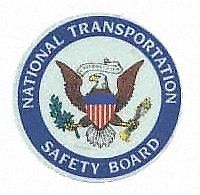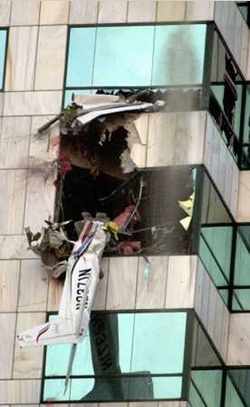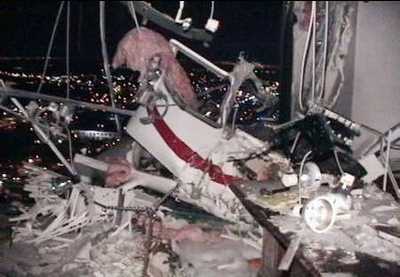Mon, Jan 20, 2003
 The final NTSB report on the sad story of Tampa
teen flyer, Charles Bishop, was filed late Friday. Bishop, 15,
stole a Cessna 172R from a Clearwater flight school, crashing it
into the 28th floor of the Bank of America Plaza in downtown Tampa,
January 5, 2002.
The final NTSB report on the sad story of Tampa
teen flyer, Charles Bishop, was filed late Friday. Bishop, 15,
stole a Cessna 172R from a Clearwater flight school, crashing it
into the 28th floor of the Bank of America Plaza in downtown Tampa,
January 5, 2002.
To no one's surprise, the NTSB has ruled the teen's death a
suicide.
The NTSB stated, "The student pilot was instructed by his flight
instructor to preflight the Cessna 172R airplane and then wait for
the instructor before beginning the training flight.
 Witnesses stated that the student pilot proceeded to the
airplane, removed the wing tie-downs, boarded the airplane, started
the engine, and immediately taxied to runway 35R without the flight
instructor. The student pilot then took off from the runway without
communicating with the airport Air Traffic Control (ATC) tower. The
tower controllers stated that the airplane turned to the right and
headed toward the southeast immediately after takeoff. No
transponder signal was received from the airplane. The tower
controllers notified Tampa ATC approach controllers, and they also
notified the pilots of a Coast Guard helicopter that was flying in
the local area. Additionally, the controllers made numerous
attempts to contact the pilot by emergency radio frequency, but
were unsuccessful. The Coast Guard helicopter pilots were asked to
intercept the airplane. The airplane proceeded to a local Air Force
military base and over flew the base control tower, two aircraft,
and three hangars at a low altitude. The airplane was then observed
to alter its heading toward a tall office building in the city of
Tampa. While en route to the building, the Coast Guard helicopter
pilots intercepted the airplane and attempted to signal the pilot
to land. According to the helicopter pilots, the student pilot saw
their hand gestures and gestured back to them; however, the
helicopter pilots could not determine the kind and meaning of the
gestures that the student pilot exhibited. Shortly thereafter, the
airplane impacted the office building at the 28th-floor level. An
examination of the airframe, systems, and engine did not reveal any
evidence of preimpact mechanical malfunction. No indications of
ethanol or drugs were found in specimens taken from the student
pilot. A 2-page suicide note was found on the student pilot’s
person."
Witnesses stated that the student pilot proceeded to the
airplane, removed the wing tie-downs, boarded the airplane, started
the engine, and immediately taxied to runway 35R without the flight
instructor. The student pilot then took off from the runway without
communicating with the airport Air Traffic Control (ATC) tower. The
tower controllers stated that the airplane turned to the right and
headed toward the southeast immediately after takeoff. No
transponder signal was received from the airplane. The tower
controllers notified Tampa ATC approach controllers, and they also
notified the pilots of a Coast Guard helicopter that was flying in
the local area. Additionally, the controllers made numerous
attempts to contact the pilot by emergency radio frequency, but
were unsuccessful. The Coast Guard helicopter pilots were asked to
intercept the airplane. The airplane proceeded to a local Air Force
military base and over flew the base control tower, two aircraft,
and three hangars at a low altitude. The airplane was then observed
to alter its heading toward a tall office building in the city of
Tampa. While en route to the building, the Coast Guard helicopter
pilots intercepted the airplane and attempted to signal the pilot
to land. According to the helicopter pilots, the student pilot saw
their hand gestures and gestured back to them; however, the
helicopter pilots could not determine the kind and meaning of the
gestures that the student pilot exhibited. Shortly thereafter, the
airplane impacted the office building at the 28th-floor level. An
examination of the airframe, systems, and engine did not reveal any
evidence of preimpact mechanical malfunction. No indications of
ethanol or drugs were found in specimens taken from the student
pilot. A 2-page suicide note was found on the student pilot’s
person."

The National Transportation Safety Board determines the probable
cause(s) of this accident as follows: The pilot's
unauthorized use of an aircraft for the purpose of commiting
suicide.
Bishop's family is suing the manufacturer of the acne drug
Accutane for $70 million last April. They claim that the medication
prompted his suicide and that the drug caused severe psychosis.
More News
Performance-Based Navigation (PBN) [ICAO] Area navigation based on performance requirements for aircraft operating along an ATS route, on an instrument approach procedure or in a d>[...]
The Airplane Came To Rest Underneath A Set Of Damaged Power Distribution Lines On The Floor Of A Coulee On June 19, 2025, at 1412 mountain daylight time, a Cessna 172K airplane, N7>[...]
Aero Linx: FAA Managers Association (FAAMA) Recognized by the FAA, FAAMA is a professional association dedicated to the promotion of excellence in public service. The Association i>[...]
From 2023 (YouTube Edition): Jet Central Micro-Turbine Engines Impress Founded in the late-1990s, Mexico City-based Jet Central produces a unique and fascinating line of micro-turb>[...]
Also: ANOTHER Illegal Drone, KidVenture Educational Activities, Record Launches, TSA v Shoes The Senate confirmed Bryan Bedford to become the next Administrator of the FAA, in a ne>[...]
 ANN's Daily Aero-Term (07.10.25): Performance-Based Navigation (PBN) [ICAO]
ANN's Daily Aero-Term (07.10.25): Performance-Based Navigation (PBN) [ICAO] NTSB Prelim: Cessna 172
NTSB Prelim: Cessna 172 ANN's Daily Aero-Linx (07.10.25)
ANN's Daily Aero-Linx (07.10.25) Classic Aero-TV: The Big Business of Diminutive Powerplants
Classic Aero-TV: The Big Business of Diminutive Powerplants Airborne 07.11.25: New FAA Bos, New NASA Boss (Kinda), WB57s Over TX
Airborne 07.11.25: New FAA Bos, New NASA Boss (Kinda), WB57s Over TX





